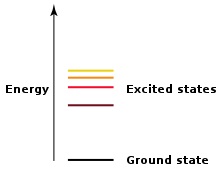
Back فراغ كمي Arabic বায়ুশূন্য দশা Bengali/Bangla Buit quàntic Catalan Κβαντικό κενό Greek Vacío cuántico Spanish Huts-egoera kuantiko Basque حالت خلأ Persian Vide quantique French Vákuumállapot Hungarian 真空状態 Japanese

| Quantum field theory |
|---|
 |
| History |
In quantum field theory, the quantum vacuum state (also called the quantum vacuum or vacuum state) is the quantum state with the lowest possible energy. Generally, it contains no physical particles. The term zero-point field is sometimes used as a synonym for the vacuum state of a quantized field which is completely individual.[clarification needed]
According to present-day[when?] understanding of what is called the vacuum state or the quantum vacuum, it is "by no means a simple empty space".[1][2] According to quantum mechanics, the vacuum state is not truly empty but instead contains fleeting electromagnetic waves and particles that pop into and out of the quantum field.[3][4][5]
The QED vacuum of quantum electrodynamics (or QED) was the first vacuum of quantum field theory to be developed. QED originated in the 1930s, and in the late 1940s and early 1950s, it was reformulated by Feynman, Tomonaga, and Schwinger, who jointly received the Nobel prize for this work in 1965.[6] Today, the electromagnetic interactions and the weak interactions are unified (at very high energies only) in the theory of the electroweak interaction.
The Standard Model is a generalization of the QED work to include all the known elementary particles and their interactions (except gravity). Quantum chromodynamics (or QCD) is the portion of the Standard Model that deals with strong interactions, and QCD vacuum is the vacuum of quantum chromodynamics. It is the object of study in the Large Hadron Collider and the Relativistic Heavy Ion Collider, and is related to the so-called vacuum structure of strong interactions.[7]
- ^ Astrid Lambrecht (2002). Hartmut Figger; Dieter Meschede; Claus Zimmermann (eds.). Observing mechanical dissipation in the quantum vacuum: an experimental challenge; in Laser physics at the limits. Berlin/New York: Springer. p. 197. ISBN 978-3-540-42418-5.
- ^ Christopher Ray (1991). Time, space and philosophy. London/New York: Routledge. Chapter 10, p. 205. ISBN 978-0-415-03221-6.
- ^ "AIP Physics News Update,1996". Archived from the original on 2008-01-29. Retrieved 2008-02-29.
- ^ Physical Review Focus Dec. 1998
- ^ Walter Dittrich & Gies H (2000). Probing the quantum vacuum: perturbative effective action approach. Berlin: Springer. ISBN 978-3-540-67428-3.
- ^ For a historical discussion, see for example Ari Ben-Menaḥem, ed. (2009). "Quantum electrodynamics (QED)". Historical Encyclopedia of Natural and Mathematical Sciences. Vol. 1 (5th ed.). Springer. pp. 4892 ff. ISBN 978-3-540-68831-0. For the Nobel prize details and the Nobel lectures by these authors, see "The Nobel Prize in Physics 1965". Nobelprize.org. Retrieved 2012-02-06.
- ^ Jean Letessier; Johann Rafelski (2002). Hadrons and Quark-Gluon Plasma. Cambridge University Press. p. 37 ff. ISBN 978-0-521-38536-7.
© MMXXIII Rich X Search. We shall prevail. All rights reserved. Rich X Search